

![]()
ROBERT BURNS
1759 - 1796
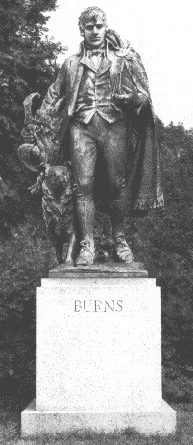
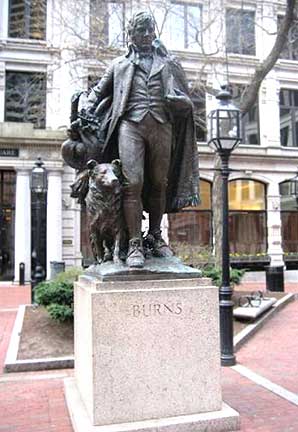
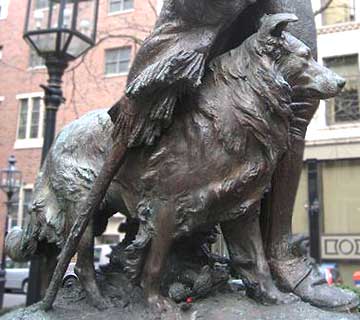
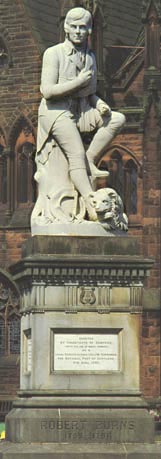
A bronze statue of Robert Burns and his sheepdog Luath by sculptor Henry H. Kitson was erected in 1920 on the Fenway in Boston, Massachusetts by the Burns Memorial Association of Boston in honor of the poet laureate of Scotland. Its beginning was marred by its first being lost in shipment between Brooklyn, New York and Boston, and spending three weeks on a railroad siding. Then the location for its erection was changed four times before the Boston Park Commission decided on the spot on the Fenway. However, once the spot was decided, the dedication was attended by every Scotsman within hailing distance and numerous Scots societies, including forty members of the Highland Dress Association pipers and drummers in a parade to the Fenway. The statue shows Burns tramping through the countryside, with Luath walking at his side. Above, far left, is a photograph of the statue as it appeared in its original site. The Fenway is a greenway winding through the Back Bay Fens in Boston. Currently the Fenway has a three-lane parkway running through it, so the only people that would see the statue would have been those zipping by in their cars, those walking their dogs, and those jogging through the park. So recently, the statue was moved to a new, more appropriate site, in Winthrop Square, downtown Boston. The photos, above, center, show the statue in it's new home.
Another statue of Burns and Luath (above, far right) was erected in 1882 in front of Greyfriers Church in Dumfries, Scotland. In that one, Burns is seated on a stump with Luath reclining at his feet, his head on his master's right foot.
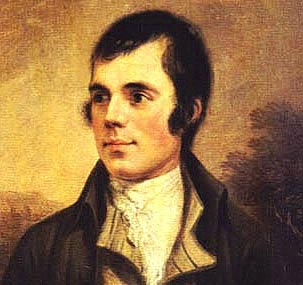
Above, Robert Burns from a portrait by Nasmyth
Robert Burns was born in Alloway, Scotland, on January 25, 1759. His grandfather had been a Jacobite sympathizer, and a tenant-farmer; and his father, William, was a landscape gardener, first in his native Kincardineshire, then in Edinburgh where he worked on private gardens and on the city's recreation park, the Meadows, and finally in Ayrshire where Robert was born. Robert was the first of seven children. He learned the old songs and stories from his mother, Agnes Broun, and her cousin, Betty Davidson. He also developed an appreciation of books from his father, to whom reading and the education of his children was very important. Later, William rented a 70-acre farm, ostensibly to save his children from becoming dependent on the employment of others. When the farm's finances prevented him from hiring outside help, his eldest son, Robert, became the farm's only laborer at 15 years of age. Burns was to remain a farmer throughout his life. The strain of the hard life is considered to have contributed to his early death at the age of 37.
Nevertheless, in his short life, Burns was an excedingly prolific author of poems, ballads and songs, among them the welknown Scottish songs Ca' the Yowes Tae the Knowes, Ye Banks And Braes of Bonnie Doon, My Love is Like a Red, Red Rose, A Man's A Man For A' That, and of course Auld Land Syne; and the poems To a Mouse, Address to a Haggis, Tam o'Shanter, and the one we are concerned with here, The Twa Dogs.
The Twa Dogs was written by Burns in 1785 when he was 26 years old. Gilbert Burns, the bard's brother, wrote this about the poem:
"Robert had a dog, which he called Luath [after Cucullin's dog in Ossian's Fingal--Luath means swift or fleet in Gaelic], that was a great favourite. The dog had been killed by the wanton cruelty of some person [and] Robert said to me that he should like to confer such immortality as he could bestow on his old friend Luath..."
The poem, however, has little to do with the dog, except for the introductory verses, which appear below, and describe the dog's looks and personality. The bulk of the work is philosophical, dealing with the contrast between the life of the rich in the 18th century and the life of the poor, a contrast that Burns experienced firsthand. The words in Scots dialect appear in italics, with the translation of those words to the right.
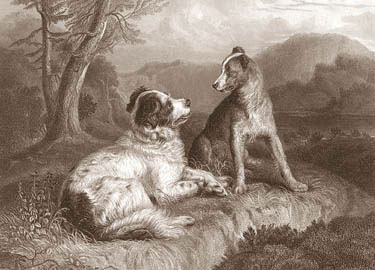
Above, The Twa Dogs by Sir Edwin Landseer,
an illustration for the poem of the same name by Robert Burns,
shows Caesar, a so-called Landseer Newfoundland on the left,
and Luath, a working collie who appears as a smooth-coated dog in this portrayal.
THE TWA DOGS by Robert Burns
Twas in the place o'Scotland's isle, That bears the name o'auld King Coil? (a.k.a., Ayrshire) Upon a bonnie day in June, When wearing through the afternoon, Twa dogsthat were na thrang at hame, (two dogs that weren't busy at home) Forgather'd aince upon a time. The first I'll name, they ca'd him Caesar, (called) Was keepit for his honour'spleasure; (kept for his master's) His hair, his size, his mouth, his lugs, (ears) Show'd he was nane o'Scotland's dogs; (none) But whalpit some place far abroad, (whelped) Where sailors gang to fish for cod. (go) His locked, letter'd braw brass collar (fine) Show'd him the gentleman and scholar; But tho he was o' high degree, Thefient a pride--nae pride had he. (devil of pride--no pride) Butwad hae spent an hour caressin' (would have) Even wi' a tinkler-gypsy's messan. (with a tinker-gypsy's cur dog) At kirk or market, mill or smiddie, (church ...smith) Nae tawted tyke, though e'er sae duddie, (no matted cur, though ever so ragged) But he wad stan't, as glad to see him, (would stand) And stroan't on stanes and hillocks wi' him (urinated on stones...with) The tither was a ploughman's collie, (other) A rhyming, ranting, roving billie (singing ...lad) Wha for his friend and comrade had him, (who) And in his freaks had Luath ca'd him, (fancy) After some dog in Highland sang, (song) Was madelang syne--Lord knawshow lang, (long ago ...knows) He was agash and faithfu' tyke; (wise) As ever lap a sheugh or dike, (leaped a ditch or wall) His honest sonsie, baws'ntface, (comely, white-striped) Aye gat him friends in ilka place, (always got ...every) His breast was white, his touzie back (shaggy) Weel clad wi' coat o' glossy black; (well) His gauncie tail, wi' upward curl, (bushy) Hung o'er hishurdles wi' a swirl. (hips) Nae doubt but they were fain o'ither, (fond of each other) And unco pack and thick thegither; (very intimate and friendly together) Wi' social nose whyles snuff'd and snokit, (sometimes sniffed and scented) Whyles mice and moudieworts they howkit; (sometimes mice and moles they dug) Whyles scour'd awa' in lang excursion, (sometimes scampered away) And worried ither in diversion; (each other) Until wi' daffin' weary grown, (with sporting) Upon a knowe they sat them down, (knoll) And there began a lang digression About the lords o' the creation.
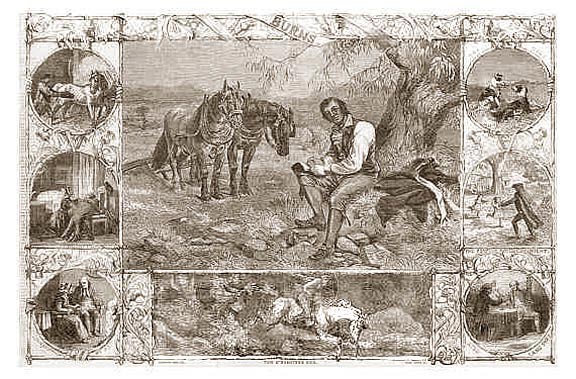
Above, an illustration that appeared in a magazine at the time of the Burns' Centeniary. The central panel shows the young farmer, Robert Burns, taking a break from plowing to sit on a rock and pen some verses. The surrounding panels all illustrate scenes from various of Burns' poems, including "The Twa Dogs" in the upper right-hand corner.
Please go to More on Robert Burns
THE OTHER WEB PAGES WE MAINTAIN
These web pages are copyright ©2013
and maintained by webmeistress Carole Presberg
with technical help from webwizard David Presberg
ALL RIGHTS RESERVED
If you are interested in using ANY material on this website, you MUST first ask for permission.